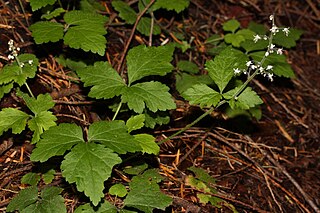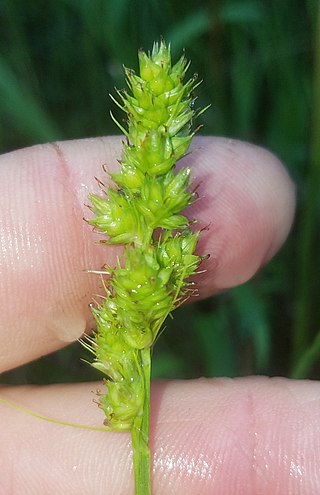
Trillium is a genus of about fifty flowering plant species in the family Melanthiaceae. Trillium species are native to temperate regions of North America and Asia, with the greatest diversity of species found in the southern Appalachian Mountains in the southeastern United States.

Tiarella cordifolia, the heart-leaved foamflower, is a species of flowering plant in the family Saxifragaceae. The specific name cordifolia means "with heart-shaped leaves", a characteristic shared by all taxa of Tiarella in eastern North America. It is also referred to as Allegheny foamflower, false miterwort, and coolwort.

Tiarella, the foamflowers, is a genus of flowering plants in the family Saxifragaceae. The generic name Tiarella means "little turban", which suggests the shape of the seed capsules. Worldwide there are seven species, one each in eastern Asia and western North America, plus five species in eastern North America. As of October 2022, the taxonomy of Tiarella in eastern North America is in flux.

Quercus austrina, the bastard white oak or bluff oak, is an oak species that is endemic to the southeastern United States from Mississippi to the Carolinas, with a few isolated populations in Arkansas.

Tiarella trifoliata, the three-leaf foamflower, is a species of flowering plant in the family Saxifragaceae. The specific name trifoliata means "having three leaflets", a characteristic of two of the three recognized varieties. Also known as the laceflower or sugar-scoop, the species is found in shaded, moist woods in western North America.

Tiedemannia canbyi is a rare species of flowering plant in the carrot family known as Canby's dropwort and Canby's cowbane. It is native to the southeastern United States, where it occurs on the Atlantic coastal plain from North Carolina to Georgia, as well as the Chesapeake Bay area. It is threatened by the loss of the wetland habitat in which it grows. It is a federally listed endangered species of the United States.

Symphyotrichum georgianum is a rare species of flowering plant in the Asteraceae, the aster family. Its common name is Georgia aster. It is native to the southeastern United States where it is known from Alabama, Florida, Georgia, North Carolina, and South Carolina. As of 2013, it may be extirpated from the state of Florida.
Tiarella wherryi is a species of flowering plant in the family Saxifragaceae. The specific name wherryi recognizes Edgar Wherry, the botanist who collected some of the first specimens in the early 1930s. Commonly called Wherry's foamflower, it is the southernmost of all species of Tiarella in the southeastern United States, where its range approaches the Gulf Coast in southern Alabama.
Arisaema quinatum, the Indian turnip or jack-in-the-pulpit, is a plant species in the Araceae. It is native to the southeastern United States from Texas and Florida north to Kentucky and North Carolina.
Arisaema pusillum is a species of flowering plant in the family Araceae. It is a member of the Arisaema triphyllum complex, a group of four closely-related taxa. The specific name pusillum means "very small, slender", which emphasizes the fact that the species is smaller and more slender than the relatively common Arisaema triphyllum.
Arisaema stewardsonii is a species of flowering plant in the family Araceae. It is a member of the Arisaema triphyllum complex, a group of four closely-related taxa. The specific name stewardsonii honors American botanist Stewardson Brown (1867–1921).

Carex austrina, known as southern sedge, is a species of sedge endemic to the southern and central United States.

Astranthium integrifolium, the entireleaf western daisy or eastern western-daisy, is a North American species of flowering plants in the family Asteraceae. It is native to the east-central part of the United States primarily the Cumberland Plateau and Ohio/Tennessee Valley. It is found in the States of Tennessee, Kentucky, Alabama, and Georgia, with isolated populations in Mississippi and West Virginia.

Quercus sinuata is a species of oak comprising two distinct varieties, Quercus sinuata var. breviloba and Quercus sinuata var. sinuata, occurring in southeast North America.

Symphyotrichum shortii, commonly called Short's aster, is a species of flowering plant in the family Asteraceae. It is native to North America, where it is primarily found in interior areas east of the Mississippi River. Its natural habitat is in thin rocky soils of woodlands and thickets often around limestone bluffs. It is common throughout much of its range, although it is generally restricted to intact natural communities.

Symphyotrichum retroflexum is a species of flowering plant in the family Asteraceae native to the southeastern United States. Commonly known as rigid whitetop aster, it is a perennial, herbaceous plant that may reach 40 to 100 centimeters tall. Its flowers have blue to purple ray florets and cream to pale yellow then pinkish disk florets. It is known only from the Blue Ridge Mountains in Alabama, Georgia, North Carolina, South Carolina, Tennessee, and Virginia, where it grows in wooded areas at elevations of 400–1,500 meters. As of September 2021, NatureServe classified it as Apparently Secure (G4); it had been reviewed last in 1994 and is marked as "needs review". There is an introduced presence of S. retroflexum in southeast China.

Symphyotrichum kentuckiense is a species of rare flowering plant in the Asteraceae family and is commonly known as Kentucky aster, Price's aster, Miss Price's aster, Sadie's aster, or lavender oldfield aster. It is a perennial, herbaceous plant that is endemic to broken limestone cedar glades and roadsides in Alabama, Georgia, Kentucky, and Tennessee. It blooms from August through October, reaches heights between 30 centimeters and 100 cm (3.3 ft), and has green to reddish-brown stems. It is a nearly hairless plant with blue to blue-violet ray florets.

Tiarella stolonifera is a species of flowering plant in the family Saxifragaceae. The specific name stolonifera means "spreading by stolons", an important characteristic of this species. Known as the creeping foamflower, it has the widest range of any species of Tiarella in eastern North America.

Tiarella nautila is a species of flowering plant in the family Saxifragaceae. The specific name nautila alludes to its sail-like stem leaves. Accordingly, it is sometimes called the sail-leaf foamflower. The species is narrowly endemic to the Blue Ridge Mountains in the southeastern United States.

Tiarella polyphylla is a species of flowering plant in the family Saxifragaceae. The specific name polyphylla means "many-leaved". The species is native to Asia, ranging from the eastern Himalayas to China, east Asia, and southeast Asia. It is sometimes called the Asian foamflower.
















